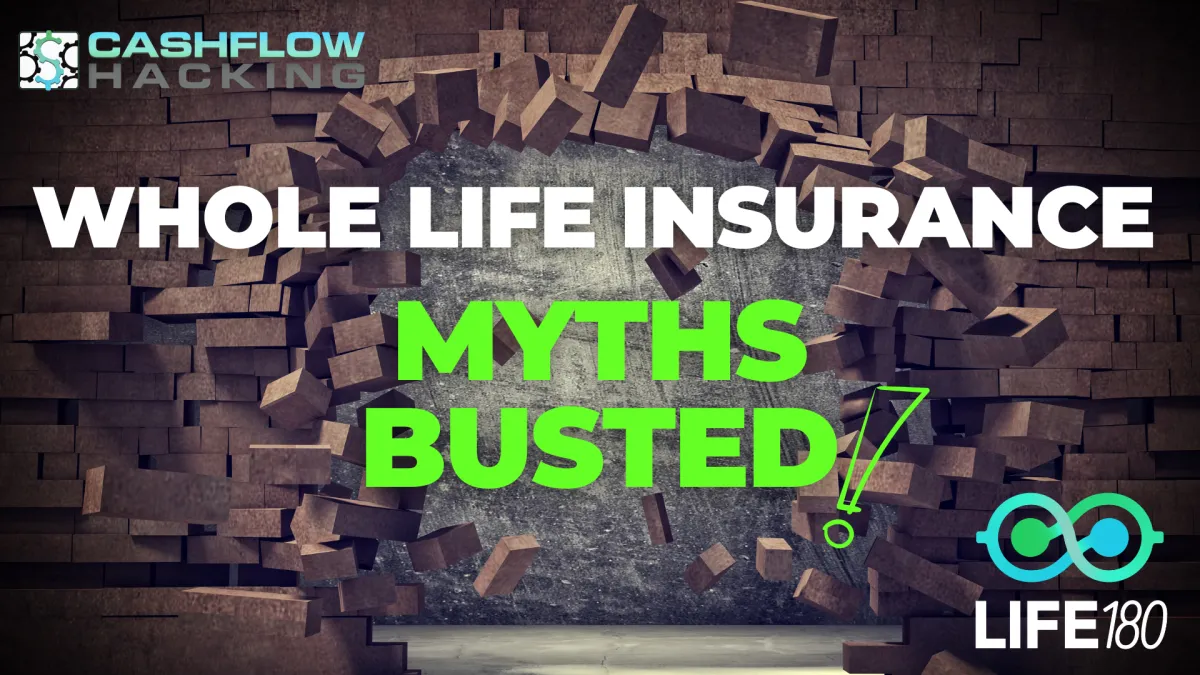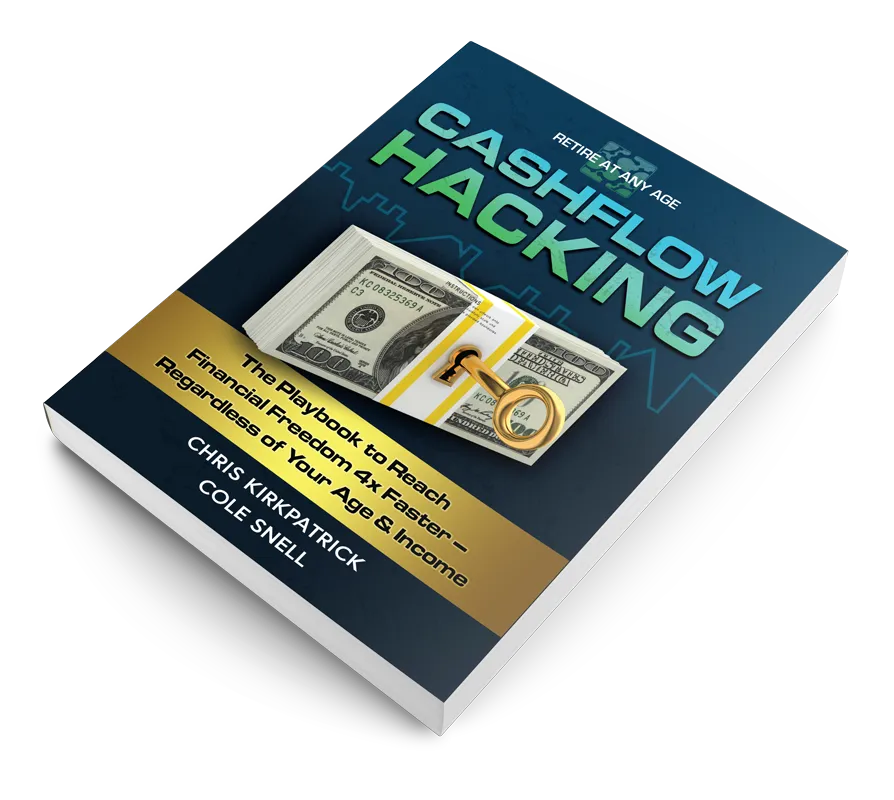
Simplifying Financial Confusion
LEARN CASH FLOW HACKING TO REACH FINANCIAL FREEDOM
Used by 90% of millionaires to reach their financial goals 4x faster

Achieve Financial Freedom Through Cash Flow Hacking

Increase Your Lifestyle While You Build Your Wealth

Position Yourself to Thrive in Market Downturn
YOU SHOULD NOT FEEL OUT OF CONTROL ABOUT YOUR FINANCIAL STRATEGY

Have easy access to your money in case of emergencies and opportunities

Use the investment strategy 90% of millionaires use

You deserve a clear plan to consistently grow your money and avoid market uncertainty

Have a guide and advisor that has your best interest in mind

Do not overpay in taxes

Stop guessing at the best vehicles to protect and grow your money

Whole Life Insurance Myths Busted: Here’s the Real Truth
Discover the full transcript of our insightful video, available exclusively on the LIFE180 YouTube channel.
Intro to whole life insurance myths busted
Have you ever wondered if whole life insurance is a financial trap or a golden opportunity? In this article, we'll delve deep into the world of whole life insurance to debunk some common myths and uncover the real truth that financial gurus don't always share.
If you're an entrepreneur, a real estate investor, or simply someone looking to secure your financial future with confidence, then this article is the essential guide you've been waiting for. I'll break down complex concepts into simple, actionable insights, empowering you to take control of your financial future.
So, if you're ready to transform your perspective and discover how whole life insurance can be a powerful tool in your financial arsenal, stick around. The truth might just surprise you.
My goal in this article is to debunk those myths, provide clarity and perspective, and help you understand the truth about these concepts. It's about encouraging you to think critically for yourself.
I strongly believe that the quality of our lives is influenced by the quality of the questions we ask. So, with that in mind, I'll now examine these myths, questioning why they exist in the first place and breaking them down. By the end of this discussion, I hope it will all make sense to you.
Myth 1 - Whole Life Insurance Is Expensive
Myth number one: Many people believe that whole life insurance is prohibitively expensive. Let's explore why this perception exists and uncover the truth behind it.
First and foremost, before we delve deeper, we must conduct a cost versus benefit analysis. While whole life insurance does have higher premiums, there's no denying that, it's crucial to consider what you're actually getting in return for those higher premiums.
Whole life insurance provides lifetime coverage and builds cash value over time, giving you access to that value. Often, within the first four to five years, you can have more cash value available inside the policy than you initially contributed. This increased coverage and liquidity allow you to utilize the money for other purposes, which we'll explore further.
This means you might pay more upfront and higher premiums for your policy, but the benefits and value you receive in return are far greater than the cost. Successful people and mentors in my life have always emphasized focusing on value rather than cost.
In comparison, term life insurance is cheaper and marketed as the most affordable option, focusing on providing the most coverage for the least amount of money. However, this race to the bottom doesn't align with the mindset of building wealth. Wealthy individuals don't achieve success by solely seeking the cheapest options; they prioritize value and long-term benefits.
Sadly, this short-term mindset can leave you vulnerable. Term life insurance provides coverage for 10, 20, or 30 years, but once that term ends, so does your coverage. This means you could find yourself without protection when you need it most.
Additionally, term insurance doesn't offer living benefits. When your policy ends in 10, 20, or 30 years, the coverage ceases, leaving you unprotected. While some advocate for buying term insurance and investing the difference, they often overlook the added value that whole life insurance provides beyond the expiration of a term policy.
Whole life insurance brings added value in the form of access to cash value, which can serve as a volatility buffer for retirement income. Additionally, it provides living benefits that can help manage medical expenses and other financial needs during retirement. These benefits extend well beyond the expiration of a term policy, offering greater security and flexibility.
At the end of the day, when your term insurance expires after 10, 20, or 30 years, whole life insurance continues to protect you for the rest of your life. It offers lifelong coverage and numerous benefits, ensuring long-term financial security and peace of mind.
One thing I always emphasize is the importance of thinking long-term. A short-term mindset often leads to unnecessary problems. Therefore, it's crucial to consider the long-term financial advantages of whole life insurance.
When I think of whole life insurance, I see it as a forced savings plan. Over time, the cash value grows tax-deferred, and you can borrow against it if needed for real estate, business ventures, private money lending, or even as an emergency fund.
The long-term financial advantages far outweigh the initial cost and the potential lack of immediate liquidity due to the premiums paid. This makes whole life insurance, in my opinion, a wise savings vehicle for those who can afford the premiums, even though it is not technically an investment.
However, it's important to only contribute to your whole life policy what you can afford to save, not invest. So, that's myth number one debunked.
Myth 2 - Whole Life Insurance Is A Cash Grab By The Life Insurance Company
Myth number two: Another misconception is that whole life insurance is merely a cash grab by the insurance companies. I want to explain and explore why this is not the case at all.
First of all, let's look at cash value accumulation. Whole life insurance policies accumulate cash value, as mentioned previously, which grows over time. This cash value acts as an additional financial resource that you can tap into when you need it the most.
We've discussed using it for real estate investing and as an emergency fund. It can also serve as a volatility buffer and be used for various other reasons. It's not just about the death benefit; it's about building a financial reservoir and establishing a foundation of financial safety.
When you build up the cash value, you can access it through policy loans or withdrawals. Different strategies are suitable for different times, so it's essential to work with someone who can guide you through the process and help you understand the positives and negatives of each decision.
Accessing these funds through withdrawals or policy loans provides financial flexibility, allowing you to use the funds for various needs. As mentioned, you can use it for real estate investing, business opportunities, and other financial ventures.
One of the great advantages of policy loans is that they are tax-free and don't require credit checks. Essentially, you have your own personal line of credit, allowing you to access funds without interrupting the compounded growth of your money.
Another key component is that not only are there no credit checks and the money is protected against lawsuits in most states, but the interest you pay on policy loans goes to the insurance company instead of a bank. This can provide additional financial benefits and security.
When you repay the insurance company, the loan is guaranteed by the cash value and death benefit of your policy, ensuring that it doesn't interrupt the growth of your policy. This structure helps maintain the financial stability and growth of your investment over time.
So if you're paying the insurance company 5% and your policy is earning 5%, it's not a loss for you. Managing your cost of capital and having control over it, especially in higher interest rate environments, is an incredibly powerful benefit that may not be immediately apparent on a spreadsheet. It's one of the most wonderful aspects of whole life insurance that I truly appreciate. So, that's myth number two debunked.
Myth 3 - Whole Life Insurance Is Only Worth It If You Die Young
I want to quickly debunk this myth: living benefits with whole life insurance provide immense value. Unlike most term insurance policies, whole life insurance covers living benefits that can significantly enhance your financial security and flexibility.
In fact, while some term insurance policies can have living benefits attached to them, these benefits are only as good as the term policy itself. This means that if the term expires in 10 to 20 years, so do the living benefits associated with it.
So the reality is that you're most likely going to need your living benefits, such as long-term care alternatives, during retirement when traditional term insurance may no longer be in effect, according to conventional financial planning.
In addition to the living benefits and accelerated benefit riders, the cash value we've discussed throughout this discussion serves as a source of funds for your retirement. You can utilize it to pay off debts or even start a business. This versatility enhances the value of whole life insurance beyond its basic coverage.
At the end of the day, I view whole life insurance as an alternative to bonds. By incorporating whole life insurance into your financial strategy, you secure a guaranteed payout with predictable growth. This stability can be a valuable addition to your investment portfolio.
By incorporating whole life insurance into your financial strategy, you gain a guaranteed payout and predictable growth in your cash value. This helps create a balanced financial plan that can adapt to various stages and needs in your life. There are countless real-life examples of people using their cash value to fund their children's education, invest in real estate, launch businesses, and more.
I have a personal story: My father-in-law was diagnosed with stage 4 pancreatic cancer at 73 years old. Given three months to live, we were able to accelerate the death benefit from one of his life insurance policies to pay for alternative medical treatments. Despite the grim prognosis associated with stage 4 pancreatic cancer, known as one of the deadliest forms, he's still alive four years later.
To me, one of the unsung heroes of life insurance is that you can actually use it while you're alive, not just after you pass away. This aspect is often overlooked but incredibly significant. So, that's myth number three debunked.
Myth 4 - Whole Life Insurance Is A Bad Investment
Some people believe that whole life insurance is a poor investment, and I want to set the record straight against figures like Dave Ramsey, Suze Orman, A.L. Williams, and others who advocate for the "buy term and invest the difference" strategy. It's unfair and unrealistic to compare whole life insurance to high-risk investment vehicles.
Instead of comparing whole life insurance to high-risk investments, we should view it as a stable, low-risk component of your financial portfolio. It offers guaranteed returns that can complement other investments such as stocks, real estate, and your business ventures.
Once again, whole life insurance serves as the financial foundation of your personal financial world. Like the foundation of a pyramid or the foundation of your house, it provides stability and security, which are crucial elements of financial planning.
When you have a whole life insurance policy, it may not offer the same returns as higher-risk investments, but it provides guaranteed returns through participation in dividends from the insurance company. This is a standout feature of whole life insurance, offering stability and predictable growth on the cash value over time.
In addition to the guarantees, you'll also receive a dividend payment. While dividends are not guaranteed, we work exclusively with companies that have a track record of over 110 years of paying dividends consecutively every single year. This consistency speaks to the reliability and financial strength of these companies.
By participating in dividends, you're essentially benefiting from the success of the insurance company, similar to owning shares in a privately held or publicly traded company. These dividends can be used to purchase paid-up additions, increasing your policy value, liquidity, cash value, and living benefits.
They significantly enhance the growth of cash value in your policy, injecting a rapid growth factor into its overall value. This feature of stacking dividends is a key element that accelerates the growth of your whole life insurance policy's cash value.
When we compare this guaranteed asset to any other guaranteed asset in the world of personal finance, nothing can match the long-term benefits that whole life insurance offers. Its stability and predictable growth make it a standout choice for securing your financial future.
Whole life insurance also provides tax advantages, which is one of its appealing features. The cash value grows tax-deferred, meaning you don't pay taxes on the growth until you withdraw it. The death benefit is typically received tax-free, and you can access the cash value tax-free through loans and withdrawals up to the amount you've paid in premiums (cost basis). These tax benefits enhance the overall financial appeal of whole life insurance as a savings vehicle.
So, once again, depending on how you utilize it, you need to ensure you're integrating it as part of a broader financial strategy and understand how to leverage the cash value in various scenarios. When used correctly, whole life insurance becomes an incredibly powerful tool.
Myth 5 - Whole Life Insurance Is Inflexible
Many people believe whole life insurance is rigid and doesn't adapt to changing needs. However, this perception is far from the truth.
There are many ways to customize your whole life insurance policy. You can add various riders to the policy, blend different types of coverage, choose from different premium payment schedules, and enhance coverages. This flexibility allows you to tailor the policy to meet your changing needs.
There are numerous options available. Additionally, you can choose different companies that offer varying levels of flexibility in premium payments, allowing you to find the best fit for your financial situation and goals.
The perceived rigidity of whole life insurance is often overstated. In reality, whole life insurance can be nearly as flexible as an Indexed Universal Life (IUL) policy, but without the downsides and lack of guarantees that come with an IUL.
Another key element of whole life insurance, especially when compared to investments, is the importance of viewing it from a value perspective. I've mentioned this before, but it bears repeating because it's a crucial point to understand.
Riders, such as accelerated death benefit riders, potential long-term care riders, and disability waivers, provide additional protection and flexibility to your policy. Once again, it's not about the cost, but the value. It's about how this asset functions as a foundational component of your finances, enabling all your other assets to perform better.
Dr. Wade Pfau, a specialist in retirement income planning, conducted a study showing that incorporating whole life insurance into your portfolio can replace the traditional 60/40 bond portfolio, where 40% is allocated to bonds. He suggests having 40% in whole life insurance instead, as it will outperform bonds over a 30-year period.
This approach not only provides the potential for higher returns but also offers additional benefits that can enable your investments to perform 25 to 50% better than they would without it. This kind of benefit and value is difficult to quantify on a spreadsheet but is incredibly impactful for your overall financial strategy.
Another aspect of whole life insurance that I love is its ability to be adjusted as your life circumstances change. I always say that whole life insurance is the only product I know that can adapt and adjust with you at every phase of your life.
If something happens, you have the flexibility to increase your coverage, potentially through the right riders attached to your policy. You can also reduce coverage, adjust your premium payments as needed, or even convert the policy into a different type of insurance through a 1035 exchange if necessary. This adaptability makes whole life insurance a versatile tool in managing your financial security.
So, hopefully, that clarifies that life insurance is not a bad investment, it's not an investment at all.
Myth 6 - Whole Life Insurance Is Only For Wealthy People
I've often received comments suggesting that whole life insurance only benefits the wealthy. Interestingly, these same individuals sometimes mention that wealthy people use it mainly for tax advantages, while they themselves consider it for protecting their family while their kids are young.
Wealthy individuals don't typically buy insurance for basic needs alone. They often utilize insurance because it's one of the most advantageous ways to pass wealth on to the next generation. By leveraging the cash value to enhance other investments and businesses, they can maximize the benefits of transferring wealth over time.
Many people misrepresent whole life insurance by claiming it's a secret tool the wealthy use to become wealthy. In reality, the wealthy use it to help grow their wealth and create a system for generating more income. However, its primary role is as a backstop for their wealth. While many individuals make money, others lose it over time due to various factors. Whole life insurance serves as a safeguard to ensure that once wealth is accumulated, it is preserved for the long term.
Once you've accumulated wealth, whole life insurance allows you to pass it on to the next generation. Moreover, it's surprisingly affordable and accessible at various income levels. You don't need to be a millionaire or spend six or five figures on premiums annually. Whole life insurance can be tailored to fit the financial capabilities of individuals across different income levels.
Now might not be the right time for you to get a whole life insurance policy. Often, I recommend focusing on cleaning up your debt and other financial priorities first. You might consider getting a convertible term policy initially. Later, once your debt is managed, you can convert it to a participating mutually held whole life insurance policy. This approach ensures that your insurance strategy aligns with your overall financial goals and readiness.
With careful budgeting and planning, middle-class families can also benefit from the security and advantages that whole life insurance offers. It can serve as an emergency fund or an opportunity fund, providing financial stability and flexibility as we've discussed. This makes whole life insurance a valuable tool for a wide range of households, not just the wealthy.
Implementing this strategy will provide a financial safety net that many middle-income families in the United States unfortunately lack. It safeguards them against unexpected expenses and secures their future, ensuring financial stability throughout their entire lives. This level of protection is crucial for building long-term financial security and peace of mind.
I could provide countless examples of people from various financial backgrounds who have successfully utilized whole life insurance to secure their financial future in diverse ways.
I could provide numerous examples of individuals who have benefited from having a whole life insurance policy. Whether it's having the life insurance available when needed, utilizing the living benefits at critical times, or accessing the cash value to invest in real estate and seize opportunities that require liquidity and capital, whole life insurance has proven invaluable in diverse situations.
The reality is that whole life insurance is a versatile tool that anyone aiming to build a solid financial foundation should seriously consider.
The Benefits of Whole Life Insurance
Let's consolidate these key benefits of whole life insurance. First and foremost, it provides financial security and peace of mind. It offers lifelong coverage, ensuring your family's financial protection regardless of what happens to you. Moreover, it guarantees a payout, giving you confidence in your financial planning.
One of the principles I always emphasize is buying insurance based on your net worth and building your cash flow. This means we can't buy more insurance than what we're capable of generating on our own. Insurance companies won't allow it. Therefore, we purchase insurance to achieve a desired future outcome.
Having this peace of mind allows you to gamify your life and reduces stress, knowing that you're on track to achieve your desired outcomes. This assurance is what you ultimately strive for in your financial planning.
Achieving this peace of mind can lead to living a healthier, lighter lifestyle, which is invaluable in itself.
As we eventually enter the legacy planning and wealth transfer stage of life, we recognize that our time is uncertain. The death benefit from your policy can serve multiple purposes, such as transferring wealth to your heirs, funding trusts, or supporting charitable causes. It's a powerful tool for shaping your legacy according to your wishes.
How you envision your legacy and what impact you want to leave on the next generation and the world is entirely up to you. Utilizing a whole life insurance policy is one of the most powerful ways to shape and secure that legacy.
Whole Life Insurance Is A Great Volatility Buffer in Retirement
Whole life insurance serves as a safeguard against market volatility, especially as a retirement income asset. Unlike investments tied to market fluctuations, it provides stable and predictable growth. By using it as a volatility buffer, you can avoid tapping into underperforming assets during retirement, thereby enhancing the performance of your overall portfolio.
I've talked about it a bunch right now, but on top of that I love whole life insurance for entrepreneurs, for investors, for real estate investors, and when we look at it, it's not just for individuals, but in fact, entrepreneurs and investors, utilizing this as a financial foundation for your investment strategy, almost as a filter in how you make your decisions on the investments that you make.
I strongly believe in the principle of assessing the upside and downside of any decision, and determining whether I can manage the risks. By using whole life insurance as a savings mechanism and building your financial foundation, it integrates you into a disciplined financial system. This approach ensures you don't overextend yourself and allows for strategic growth over time.
This principle applies across various investments, including real estate, business ventures, and other potentially risky opportunities like crypto or private money lending.
How To Choose The Right Whole Life Insurance Policy For YOU
When you analyze whole life insurance closely, you realize it's designed to offer optimal returns with minimal risk. It strikes a balance between risk management and guaranteed growth. As a cornerstone of your financial life and part of a diversified portfolio, it stands unrivaled in its ability to provide stability and long-term benefits.
So, how do you select the right whole life policy for your needs? It's crucial to approach this decision carefully, as the insurance industry can be daunting with varying opinions and practices.
First, consider your financial goals. Stephen Covey always said, we’ve got to start with the end in mind and reverse engineer a plan to get there. I always say people fail with their money because their money is not in alignment with their values and beliefs. What does that mean to you? What are your financial goals? What are your lifetime goals? What's the impact goal that you have? What's your budget? What are the specific features that you need in a policy to do for you?.
By aligning your whole life insurance policy with your values, goals, and financial situation, you can ensure it serves as a powerful tool in your overall financial strategy.
I always tell every life insurance agent that I coach, stop thinking like an agent, think like an entrepreneur. Consider what problems you're trying to help your client solve and then reverse engineer how to design a policy to help solve those problems. Ensure your policy aligns with your long-term financial strategy.
When selecting a whole life insurance policy, whether you work with me or another agent, the key is to find an agent whose values and beliefs align with your own. This alignment ensures they truly understand your financial goals. It's crucial to thoroughly research both the company and the agent you're considering. Make sure they comprehend your values, beliefs, and objectives.
Equally important is your own understanding of the product. Ensure that the agent has taken the time to perform due diligence and has answered your questions satisfactorily. This will give you confidence that they can create a policy tailored to your specific needs, rather than providing a generic solution.
Questions To Ask Your Whole Life Insurance Agent
When consulting with your agent, there are several key aspects of the policy to consider. An illustration will likely be shown to you at some point, but make sure the agent doesn't just use it to sell you on the cash value alone.
You should look closely at the cash value growth, ask questions about dividends, fees, front-load fees, the cost of insurance, and the implications of different options like premium offsets and reduced paid-up policies.
Also, examine the various riders available. Ensure they align with what you're looking for and that you fully understand all the terms, benefits, and potential challenges associated with the policy.
Now, if you're reading this, we are focused on whole life insurance. However, if you've looked into Indexed Universal Life (IUL) insurance, ensure you understand all the moving parts and the levers that IUL companies can adjust. These adjustments could be detrimental to your policy and advantageous to the insurer.
One of the reasons I love whole life insurance so much is because, contractually, the insurers are not allowed to make those detrimental adjustments. At the end of the day, if you're still here and reading this, I hope you're feeling encouraged and gaining a deeper understanding. This journey towards financial security through whole life insurance is worth the effort to learn and explore.
Hopefully, I've addressed some of your skepticism. It's natural to be skeptical, and I welcome it. There is a lot of misinformation out there, especially on the internet, about whole life insurance, IUL, and other financial products.
That's coming from me, one of the biggest advocates of whole life insurance in the world. However, I must admit it is also one of the most misrepresented products out there. You need to be really careful.
You have to be incredibly cautious about who you choose to work with. Setting realistic expectations is crucial. I always emphasize the importance of taking a long-term view. Whole life insurance isn't a get-rich-quick scheme; it's about building stability and security over time.
Have A Long Term View To Create A Life You Are Excited To Live
One key piece of advice I always stress is the importance of having a long-term perspective when it comes to Whole Life Insurance. It's definitely not a get-rich-quick scheme. Rather, it's a financial strategy that demands patience and commitment to see through. It's crucial to carefully weigh the short-term costs against the long-term benefits to determine if the trade-off aligns with your financial goals.
To achieve that, it's essential to look beyond just the premiums and assess how the policy contributes to enhancing your overall financial security and growth. This involves evaluating its role in aligning with your life goals and objectives.
And ultimately, when I reflect on how these strategies have shaped my life, enabling me to be where I am today, here in my studio in the Dominican Republic at our hotel, it underscores the practical value of having access to financial resources through the very principles I'm sharing with you now.
I've personally witnessed the impact firsthand, like my father-in-law's life prolonged by these very means. My clients have leveraged funds from their policies to launch businesses in Mexico, accessing capital when conventional banks turned them away. These stories aren't just anecdotes; they're real-life examples of the opportunities made possible through strategic financial planning.
So, this article should now provide you with increased confidence, clarity, and understanding on how to potentially leverage whole life insurance in your financial strategy.
Hopefully, you've found value in this article. I've invested a lot of time, heart, and energy into creating this content. Sharing this article is the best way to support my work, and I deeply value the responsibility of providing valuable information to you.
Until next time, have a blessed and inspirational day!
HOW TO START TAKING CONTROL OF YOUR FINANCES BY MAXIMIZING YOUR CASH FLOW AND PROTECTING YOUR ASSETS

1. Schedule Your Free Clarity Call

2. Create a Free Customized Plan

3. Get Guide to Financial Success
GET YOUR FREE COPY TO STOP USING OUTDATED RETIREMENT STRATEGIES
Cash Flow Hacking teaches you to:
Protect Your Investments
Thrive in bad markets
Reach financial freedom faster

ARE YOU LOOKING FOR:

Cash Flow Hacking teaches you to:
Security to protect your money
Increased cash flow and lifestyle
Inflation protection
Financial certainty in all economic environments
A reduction in taxes
Safe and fast access to your money with no penalties
WHO IS THIS PROGRAM FOR?

People looking for an alternative
Are you looking for alternatives to Wall Street’s “buy and hold” strategy that takes 40 years with uncertain results? Our Cash Flow Hacking strategies provide you the building blocks to get started on the right foot

Passionate Entrepreneurs
Are you looking for a financial strategy that will take your best assets (you and your businesses) and multiply their potential? Our Cash Flow hacking strategies will teach you how to invest for the future without sacrificing building your business

Real Estate
Investors
Are you a real estate investor who is burned out from being a landlord or playing the fix-and-flip game? Our Cash Flow Hacking strategies will provide you with the system to create predictable wealth AND give you the freedom you are looking for.
YOU DESERVE PEACE OF MIND AND A PLAN THAT WILL PROTECT YOUR FAMILY AND GROW YOUR WEALTH
Today you need to be more savvy than ever if you try to go at it alone.
Losing money to inflation, taxes, and just poor investment strategies is leaving you frustrated, feeling out of control and not knowing where to turn. To add to the problem, the market is flooded with advisors who have outdated advice that does not place your best interests first, but instead focuses on charging you a fee that creates guaranteed cash flow for them.
NOT YOU
We believe this is wrong and that your security and best interests should be placed first. We believe you should be in a position where you control your money, your money doesn't control you. We understand because we talk with hardworking people everyday that are losing money in the markets based on old information and feel like they are guessing at the best course of action.
We created the Cash Flow Hacking plan to help you have security and control of your money to take advantage of life's opportunities because you deserve peace of mind with your wealth. The old way of planning for retirement of… Go to school Get a job & save as much as you can in your 401k and mutual funds...is broken.
You have been lied to. Think about it, where else in life does someone tell you that the most certain way to achieve your desired result is to take on more risk? The math just doesn't work, and the results are showing in our country and world. Did you know that 90% of millionaires in the United States have 1 asset in common?
Hint: it's not stocks or mutual funds (and no...it's not crypto) How much sense does it make for you to work hard, save money, reduce your current lifestyle (because that's what you are doing when you save for the future - taking money you could use on lifestyle today and delaying gratification to a future unknown time), and hope that whatever you are doing will work three to four decades from now? If you're thinking, "not much sense at all…", you are in the right place.
With over 50 years of experience on our team, we have worked with thousands of individuals and families to achieve financial freedom faster and with more predictability by helping them invest for Cash Flow.
How does the Cash Flow Hacking Plan work? 1. Take the Cash Flow Hacking Challenge 2. Complete the LIFE180 X-Ray and determine what your Freedom Number is 3. Work with a Cash Flow Hacking expert to provide you a customized plan
The customized Cash Flow Hacking plan will give you clarity on where you are now, where you want to go (and in what time frame), and what you need to do to get there predictably.
We value and commit to you: We believe you deserve the best financial education and guidance We believe financial decisions should not be rushed but be well thought out with a plan We believe you should be in control of your money We believe we earn your trust through time, education, and proper due diligence Without a proper plan and guidance, your money can be lost to taxes, inflation, and bad investments You deserve more with the most up-to-date strategies to mitigate your risk, control your money, and earn stable returns regardless of the market Schedule a call here to attain your LIFE180 Financial X-Ray now or get started with the Cash Flow Hacking Challenge for free.
I am interested in...